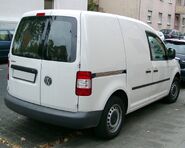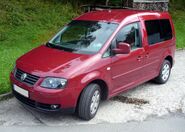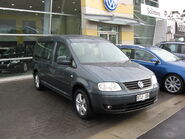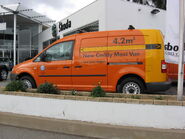 | |
| Manufacturer | Volkswagen Commercial Vehicles |
|---|---|
| Parent company | Volkswagen Group |
| Also called |
SEAT Inca Volkswagen Van |
| Production | 1980–present |
| Class | Light commercial vehicle |
| Body style(s) | Van, panel van and pickup truck |
| Layout |
Transverse front engine, front-wheel drive |
The name Volkswagen Caddy is a light commercial vehicle produced by the Volkswagen Group since 1980. It is sold in Europe and in other markets around the world. The Volkswagen Caddy was first introduced into international markets in 1980 and later in 1982 in Europe. The following vehicles are related to the Volkswagen Caddy and are also manufactured by the Volkswagen Group.
- Typ 14 was derived from the Volkswagen Golf Mk1,
- Typ 9K was derived from the Volkswagen Polo Mk3 (VW Caddy) / SEAT Ibiza Mk2 (SEAT Inca) platform,
- Typ 9U was derived from the Škoda Felicia pick-up,
- Typ 2K was derived from the Volkswagen Touran platform with Golf Mk5 front suspension.
Caddy Typ 14 (1980-1999) []
 | |
| Manufacturer | Volkswagen |
|---|---|
| Production |
Westmoreland County, Pennsylvania, USA Sarajevo, Bosnia and Herzegovina South Africa Argentina[1] |
| Successor | Volkswagen Caddy typ 9U |
| Class | Light commercial vehicle |
| Engine(s) |
1.0 petrol 1.3 petrol 1.5 petrol 1.5 diesel (1980) 1.6 petrol 1.7 petrol 1.6 diesel w/turbo in Canada and abroad 1.8 petrol 1.6 petrol 63 kW 1.6 petrol 60 kW 1.6 diesel 44 kW 1.8 petrol 70 kW |
| Related | Volkswagen Golf Mk1 |
Released in 1980, the first Volkswagen Caddy is a light pickup truck, and van based on the Volkswagen Group A1 platform, shared with the small family car Volkswagen Golf Mk1.
Volkswagen Typ is:
- 147 = LHD
- 148 = RHD
History[]
Caddy debuts internationally as a Rabbit[]
The Caddy came into fruition when Volkswagen was experimenting with Golf derivatives, an estate and a pickup.
Volkswagen of America was interested in the pickup, when Volkswagen released the Caddy it first was produced at the VWs Westmoreland County plant in Pennsylvania from 1979 to 1982. It was known in North America as the VW Rabbit Pickup with trim levels such as LX and Sportruck.[2]
The Caddy competed with other mini-pickups such as the Ford Courier and Subaru Brat of that time.
Caddy debuts in Europe[]
The Caddy nameplate was never used in the USA (since the name is slang for Cadillac motor car division). Its first use was in Europe in 1982, when the Caddy was debuted on the European Market.
European Caddys were built in Volkswagen's plant TAS in Sarajevo, Bosnia and Herzegovina from 1982 till 1992.
As of 2006[update], these original variants are still produced in South Africa. The stamping equipment was shipped from Westmoreland County, Pennsylvania, the home of Volkswagen's only U.S. manufacturing plant, now defunct.[2]
Engine specs[]
The 1980-1984 Caddy pickup used the following engines:
- 1.0 petrol
- 1.3 petrol
- 1.5 petrol
- 1.5 diesel (1980)
- 1.6 petrol
- 1.7 petrol
- 1.6 diesel w/turbo in Canada and abroad
- 1.8 petrol
The current (post 2003) South African-spec VW Pickup (Caddy name dropped to not conflict with Caddy 2K) is only available with a 1.6 carb-fed engine producing 60 kW.
However during its long production in South Africa it has been available with the following engines:
- 1.6 petrol 63 kW
- 1.6 petrol 60 kW
- 1.6 diesel 44 kW
- 1.8 petrol 70 kW
Gallery[]
Caddy Typ 9K (1996-2004) []
 | |
| Manufacturer | Volkswagen |
|---|---|
| Production | Martorell, Spain |
| Predecessor | Volkswagen Caddy typ 14 |
| Class | Light commercial vehicle |
| Engine(s) |
|
| Related |
Volkswagen Polo Mk3 SEAT Ibiza 6K SEAT Inca |
[[|thumb|Caddy II (Typ 9KV)]] Released in 1996, the Volkswagen Caddy Typ 9K was a light van designed by the VW's Spanish subsidiary SEAT, and derived from the SEAT Ibiza 6K, on the Volkswagen Group A03 platform, K.
It was built in Spain, at the Martorell factory of SEAT. This version of the Caddy was built from 1997 to 2003 in Europe. Its twin, the SEAT Inca, was quickly phased out when the SEAT marque was re-aligned as the "sporty" branch of the Volkswagen Group.
It is still under production in Argentina for the Latin American market.[3] It received a cosmetic facelift in 2005, similar to the post-1999 Volkswagen Polo Mk3.
Features
- length 4.2 m
- loading area 2.6 m2
- loading volume of 2.9 m3
- payload 550 kg
- two rear wing doors standard
- partition separating loading from driving space
- instruments with adjustable lighting
- power steering
- rear window heater
- rear windshield wiper
- dust and pollen filter
- side impact protection
- safety steering column with collapsable steering wheel
- two head restraints
- three point seatbelts
- drivers airbag passenger optional
- ABS with Electronic Differential Lock (EDL)
- air-conditioner
Note: The Electronic Differential Lock (EDL) employed by Volkswagen is not - as the name suggests - a differential lock at all. Sensors monitor wheel speeds, and if one is rotating substantially faster than the other (i.e. slipping), the EDL system momentarily brakes it. This effectively transfers all the power to the other wheel.
1996-2003MY Engines
- 1.4L Petrol 44 kW / 60 hp
- 1.4L Petrol 16 valve 55 kW / 75 hp
- 1.6L Petrol 55 kW / 75 hp
- 1.7L Diesel SDI 42 kW / 56 hp
- 1.9L Diesel D 47 kW / 64 hp
- 1.9L Diesel SDI 47 kW / 64 hp
- 1.9L Diesel TDI 66 kW / 90 hp
Caddy Typ 9U []
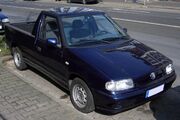
Caddy II Pickup (9U)
Released in 1996 to complement the Typ 9K Caddy range, the rebadged Škoda Felicia Utility was the entry level light commercial vehicle for the VWCV range.
The Typ 9U Caddy was built in Škoda Auto's Kvasiny, Czech Republic plant.
Engines
- 1.6L MPI Petrol with 55 kW / 75 hp
- 1.9L Diesel with 47 kW /64 hp
Features of Typ 9U Caddy
- 530 kg payload rating
- 2.0 m2 loading area
- twin airbags
- length 4.12m
- width of 1.64m
- turning circle of 11.2m
- 3 point seatbelts
- option of twin airbags
- option of ABS brakes
- option of air-conditioning standard in Petrol model.[4]
Caddy Typ 2K (2004-present) []
 | |
| Manufacturer | Volkswagen |
|---|---|
| Successor | Volkswagen Caddy typ 9K |
| Class | Light commercial vehicle |
| Engine(s) |
1.4 16V – 75 PS (55 kW/74 hp) – 126 N·m (93 lb·ft) (petrol) (discontinued) 2.0 TDI – 140 PS (100 kW/140 hp) – 320 N·m (240 lb·ft) (diesel) |
| Related | Volkswagen Golf Mk5 |
The third generation of Volkswagen Caddy debuted In late 2003 at the RAI Commercial Vehicle Show in Amsterdam, Volkswagen Commercial Vehicles debuted the Typ 2K Caddy panel van. In late 2010 the caddy underwent a face lifted to match the new design language of Volkswagen vehicles, the changes included a more aggressive front with new headlights and grill similar to the Volkswagen Golf Mk6.
The Typ 2K shares 50% of its modules with the Volkswagen Golf Mk5 and Volkswagen Touran. The new model Caddy has a more aerodynamic design, the angle of the windscreen and A-pillar is more horizontal, this makes the dashboard big and the bonnet (hood) small.
The full Caddy line-up varies from a Panel Van, Window Panel Van, Kombi (spartan seven-seat version), Caddy Life (7-seat family version), and a Camping version called the Caddy Tramper or Caddy Life Camper.
Variations[]
Caddy Panel Van[]
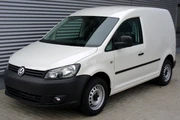
Caddy facelift.
The Caddy Panel grew in size over the Caddy Typ 9K, it measures in length 4405 mm, width 1802 mm, height 1833 mm, wheelbase 2682 mm, has a 750 kg payload, and a loading volume of 3.2 m3.
The current shape Typ 2K Caddy for sale now in Europe since 2004 is a leisure activity vehicle with Volkswagen Golf Mk5 front suspension.
It resembles the compact MPV Touran, and is assembled at the Poznań factory in Poland, and in Changchun, China for FAW Volkswagen.
Caddy Life[]
The Caddy Life, a seven seat passenger orientated People Mover, debuted at the 2004 Frankfurt Show. It comes with twin sliding doors and a 608 kg payload.
Caddy Life has a flexible seating system. The two rear bench seat rows can be taken out of the vehicle altogether to give the vehicle 2850 litres of cargo room; if that's not enough the Caddy Life has a 1500 kg towing capacity.
In 2005, a Special Edition Caddy Life Colour Concept with two distinctive colours Red Spice and Ravenna Blue was released with upholstery fabrics, floor mats and a variety of other elements on the dash panel in the same colour as the exterior body, and a leather trimmed steering wheel, gear and handbrake lever.[5]
Caddy Maxi and Caddy Maxi Life[]

Caddy Maxi
Debuting at the 2007 Frankfurt Motor Show Volkswagen Commercial Vehicles presented the Caddy Maxi Life the people mover version of the Maxi range.
The Caddy Maxi range carried over all of the Caddy engine and debuted for the first time the 2.0L TDI engine producing 103 kW/140 PS.[6]
The Caddy Maxi family is 470 mm longer version of the Caddy with 4.2 m3 loading space, this is due to extensions of the wheelbase which measures 3002 mm an extended, rear overhang now 151 mm, plus the growth between the sliding doors and the rear axle now at 319 mm and payload is up to 800 kg to 810 kg on commercial versions.
The Caddy Maxi Tramper the camping version if the Caddy Maxi debuted at the 2008 AMI Leipzig Motor Show along with the Caddy Maxi EcoFuel Study.
Caddy Life Tramper (Camper)[]

Caddy Life Tramper
Based on the Caddy Life the Tramper or Camper (Australia) package comes with two seats and a table, a fold out awning that is packaged within the rear tailgate, a bed that is made by folding down the seats measures 1.10 m x 2.0 m, also curtains are standard for privacy, options include a 7 litre cool box.
Carrera Cup Edition[]
It is a limited (250 units) version for Swedish market. It was based on the 2.0L TDI model with black 17-inch wheels with 225/45R17 tires, a new body kit, white body with red trim, black and red leather sport seats, a fire extinguisher under the passenger's seat, a sport leather steering wheel and gear knob.
The vehicle has MSRP of 250,000 Swedish Kronas ($34,200 USD or €22,000).[7]
Caddy 4Motion[]
At the 2008 IAA (Hanover Motor Show) Volkswagen Commercial Vehicles revealed the all wheel drive Caddy 4Motion range teamed with the 1.9 TDI engine and manual transmission.[8]
Early in 2010 the Caddy Maxi range will receive the 4Motion drivetrain.[9]
Caddy in Australia[]
Since its introduction in the Australian market in 2005, the Caddy range has taken the market lead for Small Van market.
Even with the more premium pricing over its competition, buyers still pay more for the TDI and DSG transmission options.[10]
In 2007, Caddy almost had 42% of the Small Van market share.[11]
Awards[]
- Professional Van and Light Truck Magazine's Small Van of the Year 2007 (UK)
- Van Fleet World's Best Small Van 2007 (UK)
- Fleet News - 2008 Best Small Van Award[12]
- Professional Van and Light Truck Magazine's Small Van of the Year 2008 (UK) - Caddy Maxi[13]
- Delivery Magazine Award - 2008 Best Small Van Caddy Maxi[14]
- What Van? (UK) - Editor's Choice 2008 Caddy Maxi [15]
Engines[]
- 1.4 16V – 75 PS (55 kW/74 hp) – 126 N·m (93 lb·ft) (petrol) (discontinued)
- 1.4 16V – 80 PS (59 kW/79 hp) – 132 N·m (97 lb·ft) (petrol)
- 1.6 8V – 102 PS (75 kW/101 hp) – 148 N·m (109 lb·ft) (petrol)
- 2.0 EcoFuel – 109 PS (80 kW/108 hp) – 160 N·m (120 lb·ft) (CNG)
- 1.9 TDI – 75 PS (55 kW/74 hp) – 210 N·m (150 lb·ft) (diesel)
- 1.9 TDI – 105 PS (77 kW/104 hp) – 250 N·m (180 lb·ft) (diesel)
- 2.0 SDI – 69 PS (51 kW/68 hp) – 140 N·m (100 lb·ft) (diesel) (only for panel van and panel window van)
- 2.0 TDI – 140 PS (100 kW/140 hp) – 320 N·m (240 lb·ft) (diesel)
Gallery[]
References[]
| This page uses some content from Wikipedia. The original article was at Volkswagen Caddy. The list of authors can be seen in the page history. As with Tractor & Construction Plant Wiki, the text of Wikipedia is available under the Creative Commons by Attribution License and/or GNU Free Documentation License. Please check page history for when the original article was copied to Wikia |
- ↑ Volkswagen Caddy website for Argentina
- ↑ 2.0 2.1 Volkswagen Driver, December 2005, page 47 to 50 - UK Publication
- ↑ Volkswagen Caddy website for Argentina
- ↑ Press Release from VWCV (Press Access needed)
- ↑ Volkswagen Media Services - In brief: 2005 Frankfurt International Motor Show - Series of new Volkswagen models ... Caddy Life Colour Concept
- ↑ The VW Gazette Caddy Maxi – World premiere at the IAA Frankfurt 2007
- ↑ VW Caddy Carrera Cup Edition 2.0TDI R
- ↑ http://vwphaetonfan.blogspot.com/2008/09/first-caddy-with-four-wheel-drive.html
- ↑ http://www.volkswagen-nutzfahrzeuge.de/de/de/unternehmen/sponsoring/Transeurasia.html
- ↑ CarsGuide.com.au Citroen gives life to Berlingo
- ↑ LCV Australia magazine Issue 11 page 26 and 27
- ↑ Volkswagen Caddy wins' Best Small Van'award
- ↑ Volkswagen Van News | Awards for Volkswagen Caddy Maxi and Crafter Chassis Cab
- ↑ Delivery Magazine Issue 18 June/July 2008 page 28
- ↑ http://www.volkswagen-vans.co.uk/press-releases/further-award-recognition/
External links[]
official sites
- VWCV UK's Caddy website
- VW Australia's Caddy website
- VW International's Caddy Camper website
- VW Australia's Caddy Life website
unaffiliated independent sites
- Popular forum for 2k chassis Caddy owners(UK&Ireland mostly)
- CaddyKulture French Forum Caddy Pick-up
- VW Caddy.net info + Tuning source for Caddy Vans
- The Caddy Shack forum Community for Caddy Vans
- vwCaddyForum.com
- Australian VW Vans & 4WD forum
- Australian Caddy (Type 2K) forum
- VWvortex Vans & Transporter forums
- VOLKSWAGEN Caddy Kombi 1.9 TDI 4Motion - 2009 - Test drive and review by Autoevolution.com
| ||||||||||||||||||||||||||
| Volkswagen Commercial Vehicles timeline, European market, 1950–present — a marque of the Volkswagen Group | ||||||||||||||||||||||||||||||||||||||||||||||||||||||||||||||
|---|---|---|---|---|---|---|---|---|---|---|---|---|---|---|---|---|---|---|---|---|---|---|---|---|---|---|---|---|---|---|---|---|---|---|---|---|---|---|---|---|---|---|---|---|---|---|---|---|---|---|---|---|---|---|---|---|---|---|---|---|---|---|
| type / class |
1950s | 1960s | 1970s | 1980s | 1990s | 2000s | 2010s | |||||||||||||||||||||||||||||||||||||||||||||||||||||||
| 0 | 1 | 2 | 3 | 4 | 5 | 6 | 7 | 8 | 9 | 0 | 1 | 2 | 3 | 4 | 5 | 6 | 7 | 8 | 9 | 0 | 1 | 2 | 3 | 4 | 5 | 6 | 7 | 8 | 9 | 0 | 1 | 2 | 3 | 4 | 5 | 6 | 7 | 8 | 9 | 0 | 1 | 2 | 3 | 4 | 5 | 6 | 7 | 8 | 9 | 0 | 1 | 2 | 3 | 4 | 5 | 6 | 7 | 8 | 9 | 0 | 1 | |
| car-derived van | Caddy 14 | Caddy 9U / 9K | Caddy 2K | |||||||||||||||||||||||||||||||||||||||||||||||||||||||||||
| pickup truck | Taro | Amarok | ||||||||||||||||||||||||||||||||||||||||||||||||||||||||||||
| campervan | Westfalia California | California (T5) | ||||||||||||||||||||||||||||||||||||||||||||||||||||||||||||
| panel van derivatives | Transporter Type 2 - (T1) Splittie | Transporter Type 2 - (T2) Bay | Transporter / Caravelle Type 2 (T3/T25) | Transporter / Caravelle / Multivan (T4) | Transporter / Kombi / Caravelle / Multivan (T5) | |||||||||||||||||||||||||||||||||||||||||||||||||||||||||
| LT (1st generation) | LT (2nd generation) | Crafter | ||||||||||||||||||||||||||||||||||||||||||||||||||||||||||||
| concepts and future models: Microbus Concept | ||||||||||||||||||||||||||||||||||||||||||||||||||||||||||||||
| founder: German Auto Association • Volkswagen Commercial Vehicles corporate website • A marque of the Volkswagen Group • 4motion | ||||||||||||||||||||||||||||||||||||||||||||||||||||||||||||||
| Volkswagen Passenger Cars, a marque of the Volkswagen Group, car timeline, South American market, 1980–present | |||||||||||||||||||||||||||||||||
|---|---|---|---|---|---|---|---|---|---|---|---|---|---|---|---|---|---|---|---|---|---|---|---|---|---|---|---|---|---|---|---|---|---|
| Type | 1980s | 1990s | 2000s | 2010s | |||||||||||||||||||||||||||||
| 0 | 1 | 2 | 3 | 4 | 5 | 6 | 7 | 8 | 9 | 0 | 1 | 2 | 3 | 4 | 5 | 6 | 7 | 8 | 9 | 0 | 1 | 2 | 3 | 4 | 5 | 6 | 7 | 8 | 9 | 0 | 1 | 2 | |
| Economy car | Gol / Parati I | Gol / Parati IF | Gol / Parati II | Gol / Parati / Gol Country III | Gol / Parati / Gol Country IV | ||||||||||||||||||||||||||||
| Gol V | |||||||||||||||||||||||||||||||||
| Voyage / Gacel | Amazon / Senda | Polo Classic | Voyage V | ||||||||||||||||||||||||||||||
| Supermini | Fox / CrossFox | ||||||||||||||||||||||||||||||||
| SpaceFox / Suran | |||||||||||||||||||||||||||||||||
| Polo IV | Polo IVF | ||||||||||||||||||||||||||||||||
| Small family car | Pointer | Golf III | Golf IV | Golf IVF | |||||||||||||||||||||||||||||
| Apollo | Logus | Bora | Vento / Jetta V | Vento / Jetta VI | |||||||||||||||||||||||||||||
| Large family car | Passat I | Passat IV | Passat V | Passat VI | Passat VII | ||||||||||||||||||||||||||||
| Santana / Corsar / Carat / Quantum | |||||||||||||||||||||||||||||||||
| Van | Caddy III | ||||||||||||||||||||||||||||||||
| Pickup truck | Saveiro I | Saveiro IF | Saveiro II | Saveiro III | Saveiro IV | Saveiro V | |||||||||||||||||||||||||||
| Amarok | |||||||||||||||||||||||||||||||||
| Panel van | Kombi | ||||||||||||||||||||||||||||||||
| |||||||||||||||||||||||||||||||||

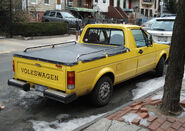
![Vw caddy 1 a sst.jpg (490 KB) Caddy Type 14 with a camper kit attached to the bed]]](https://static.wikia.nocookie.net/tractors/images/b/b5/Vw_caddy_1_a_sst.jpg/revision/latest/scale-to-width-down/185?cb=20110414154711)
